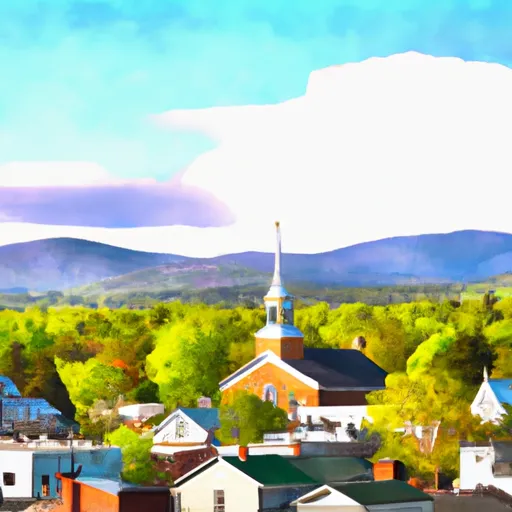-
 Snoflo Premium
Snoflo Premium
Get unlimited access to all our content
With no Ad interruptions! - Start Your Free Trial Login with existing account
West-Topsham
Eden Index
Climate
7.1
•
Recreation
4.1
•
Community
•
Safeguard
4.3/10

West Topsham is a charming town located in Orange County, Vermont. It experiences a humid continental climate characterized by warm summers and cold winters. The average temperature ranges from 15°F (-9°C) in winter to 80°F (27°C) in summer. Annual precipitation is around 45 inches, with rainfall spread relatively evenly throughout the year.
West Topsham is blessed with abundant natural water resources. The town is home to several small rivers and streams, including the Waits River and its tributaries. These water bodies provide excellent opportunities for fishing, kayaking, and canoeing. The area also features numerous picturesque ponds and lakes, such as Lake Fairlee and Lake Morey, which are popular for swimming, boating, and ice skating.
Outdoor enthusiasts will find a plethora of recreational activities in West Topsham. The town is surrounded by beautiful forests, making it ideal for hiking, camping, and wildlife observation. Its scenic landscapes offer great opportunities for photography and picnicking. During the winter, residents and visitors can enjoy cross-country skiing, snowshoeing, and snowmobiling on the town's extensive trail network.
In summary, West Topsham, Vermont, offers a diverse climate with distinct seasons, abundant hydrology constituents, and a range of outdoor recreation opportunities throughout the year.
What is the Eden Index?
The Snoflo Eden Index serves as a comprehensive rating system for regions, evaluating their desirability through a holistic assessment of climate health, outdoor recreation opportunities, and natural disaster risk, acknowledging the profound impact of these factors on livability and well-being.
Climate Health Indicator (CHI): 7.1
West-Topsham receives approximately
1128mm of rain per year,
with humidity levels near 79%
and air temperatures averaging around
5°C.
West-Topsham has a plant hardyness factor of
4, meaning
plants and agriculture in this region thrive during a short period during spring and early summer. Most
plants will die off during the colder winter months.
By considering the ideal temperature range, reliable water supplies, clean air, and stable seasonal rain or snowpacks, the Climate Health Indicator (CHI) underscores the significance of a healthy climate as the foundation for quality living.
A healthy climate is paramount for ensuring a high quality of life and livability in a region, fostering both physical well-being and environmental harmony. This can be characterized by ideal temperatures, reliable access to water supplies, clean air, and consistent seasonal rain or snowpacks.
Weather Forecast
Streamflow Conditions
Upper Connecticut
Area Rivers
Upper Connecticut
Snowpack Depths
Upper Connecticut
Reservoir Storage Capacity
Upper Connecticut
Groundwater Levels
Recreational Opportunity Index (ROI): 4.1
The Recreational Opportunity Index (ROI) recognizes the value of outdoor recreational options, such as parks, hiking trails, camping sites, and fishing spots, while acknowledging that climate plays a pivotal role in ensuring the comfort and consistency of these experiences.
Access to outdoor recreational opportunities, encompassing activities such as parks, hiking, camping, and fishing, is crucial for overall well-being, and the climate plays a pivotal role in enabling and enhancing these experiences, ensuring that individuals can engage in nature-based activities comfortably and consistently.
Camping Areas
| Campground | Campsites | Reservations | Toilets | Showers | Elevation |
|---|---|---|---|---|---|
| Quechee State Park | 55 | 638 ft | |||
| New Discovery State Park | 47 | 1,738 ft | |||
| Mt. Ascutney State Park | None | 518 ft | |||
| Ricker Pond State Park | 27 | 1,118 ft | |||
| Stillwater State Park | 62 | 1,129 ft | |||
| Eden Rec Area | None | 1,251 ft | |||
| Big Deer State Park | 23 | 1,179 ft | |||
| Storrs Pond Rec Area | 30 | 591 ft |
Nearby Ski Areas
Catastrophe Safeguard Index (CSI):
The Catastrophe Safeguard Index (CSI) recognizes that natural disaster risk, encompassing floods, fires, hurricanes, and tornadoes, can drastically affect safety and the overall appeal of an area.
The level of natural disaster risk in a region significantly affects safety and the overall livability, with climate change amplifying these risks by potentially increasing the frequency and intensity of events like floods, fires, hurricanes, and tornadoes, thereby posing substantial challenges to community resilience and well-being.
Community Resilience Indicator (CRI):
The Community Resilience Indicator (CRI) recognizes that education, healthcare, and socioeconomics are crucial to the well-being of a region. The CRI acknowledges the profound impact of these elements on residents' overall quality of life. By evaluating educational resources, healthcare accessibility, and economic inclusivity, the index captures the essential aspects that contribute to a thriving community, fostering resident satisfaction, equity, and social cohesion.

